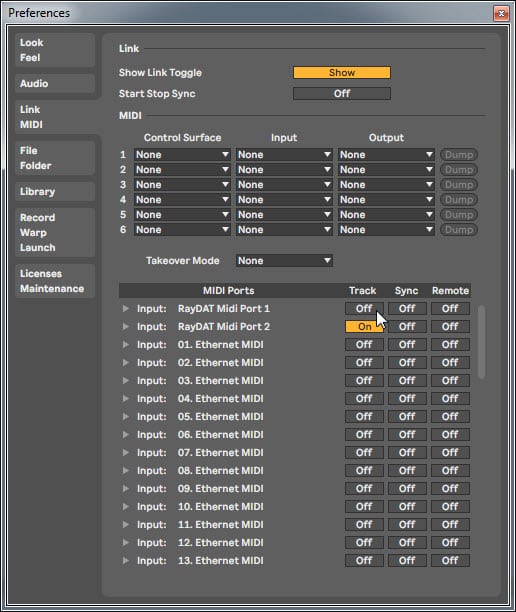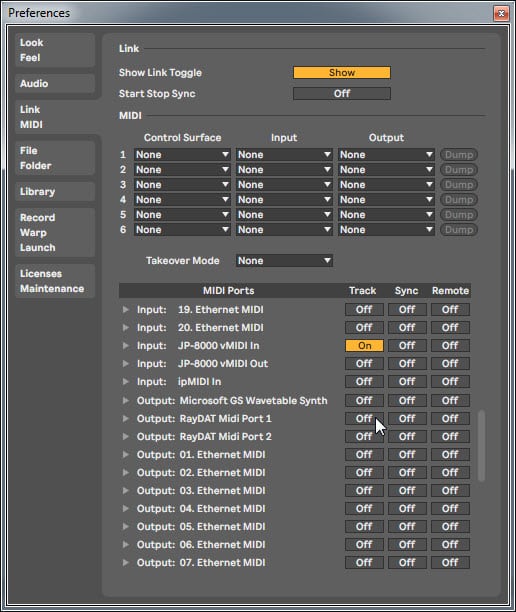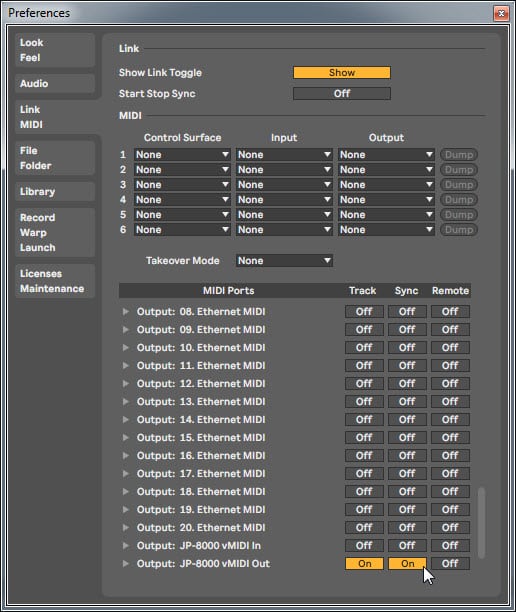Configuration articles and guides for software and hardware. These settings are mandatory unless otherwise stated
In a hurry? Download User Guide for Ableton Live to read offline
v1.0.1 – 2020-March-08
In this little Ableton Live User Guide you will find the instructions to get our plug-in to work with Ableton Live with ease. This is universal tutorial for all of our plug-in, but we are using our Roland JP-80×0 Editor in this guide.
Checkout the Editor user manual prior to this guide, so you have the knowledge to setup the Editor properly.
Also, as we are not Ableton Live experts, we engourage you to read the Renoise manual in order to fully understand your DAW.
We hope you have taken all the necessary precautions prior to using our product, like making a full backup of your synthesizer memory.
DISCLAIMER
Our company & plug-in has nothing to do with Ableton company, so please don’t bug them if you encounter issues with the Editor – open a support ticket in your account page in such case. You can find support details at the end of this document.
Support is free to anyone who has bought the license from our store
Ableton Live
Preferences
Open your DAW and enter Preferences. Lets check that the MIDI ports are free for the plug-in to use. This will ensure that your DAW won’t crash and we won’t be getting double data in to the DAW processing loop.
Windows: Options -> Preferences…
macOS: Live -> Preferences…
Link / MIDI settings
Open Link / MIDI tab in preferences. Locate the Input port, which receives MIDI from your synth. Now check that the physical input port has Track, Sync and Remote toggled OFF.
Example: My JP-8000 MIDI Out sends MIDI to RayDAT Port 1 Input. Toggle OFF all options in it.
Windows: Now in the next image you can see how I have enabled JP-8000 vMIDI In for tracking as I’m using my JP-8000 as a master keyboard. You can also see how I have deactivated Output: RayDAT Port 1 which is important!
Windows: Finally, set Track and Sync on for our JP-8000 vMIDI Out port, which sends to synth via MIDI-OX.
macOS: You can set Track and Sync on for the physical MIDI Out port, which sends to synth.
Windows: Check that the physical MIDI port of your synth is not receiving or sending MIDI data in Control Surface section. We need to be 100% sure that the port is free for the plug-in to use!
Now we can close Preferences and move on!
NOTE #1: Check our support site for additional guides like Setting MIDI Devices to learn how we added JP-8000 vMIDI In and JP-8000 vMIDI Out ports in the DAW.
You can adapt the settings to your Hardware!
Insert the plug-in
Drag the plug-in from the Plug-ins pool to the track you want.
Plug-in window will now appear. Toggle OFF track ARM switch before you continue any further! Otherwise Live will force the MIDI data to the plug-in twice, which is not what we want.
MIDI IN / MIDI OUT
Now we can select the Physical MIDI input port which receives MIDI data from your synthesizer.
And then we choose the Physical MIDI Out port which sends data to the synthesizer MIDI input.
Plug-in will now attempt to establish connection with the synthesizer, so it might take some time if your settings are not right or if you chose a wrong MIDI port by mistake. You should see plug-in saying PROCESSING… somewhere in the plug-in interface and also ABORT PROCESS button will appear.
If all of the settings are correct, you will see “Plug-in is ready to go!” [1] message in the plug-in display.
If something is wrong with your settings, plug-in will say “No response from JP!” [1] and that indicates something is wrong with your synth settings, MIDI device or Studio One Preferences.
Once the connection is in, you should sync the data with your hardware. Usually this function can be ran from the patch librarian tab / page of the plug-in & “Sync Data From HW” button. Check the plug-in user manual to learn more.
We can now close the plug-in window and move on.
Note #1: Check troubleshooting from the Editor, DAW or synthesizer manual if you can not establish connection. You can also seek help from our support site if you can’t find out what is causing error in your setup.
Automating Plug-in Parameters
First, we need to click “Unfold Device Parameters” in Live window. See image below.
Next we are going to open up the plug-in window and click “Configure” in Live. See image below.
Now that Live is in “Learn” mode so to speak, we can simply move a knob in the plug-in user interface to tell Live that the parameter is available for automation. I have moved Filter Cutoff in the plug-in interface to notify Live about the parameter existance. See image below.
Toggle off “Configure” mode from Live to confirm your parameter mappings.
Click “View” and choose “Automation Mode” from Live’s menu.
Now we can see the parameters we just mapped in the arrange view.
Start drawing in OR move the knobs in the plug-in while recording to make automation! Before you start to pursue with MIDI blocks, read the next chapter!
Note #1: You can add as many parameters as you wish. System Exclusive (SysEx) parameters and system buttons can not be automated.
Note #2: With some Editors, it is not yet possible to draw automation in DAW when moving the knob from the hardware. Move knob from the Editor user interface instead.
Assign MIDI tracks to Live arrangement
Now, in order to send MIDI notes to the synthesizer, we need to have MIDI tracks in the DAW. In Live I’ve added MIDI track to the arrange. MIDI out is pointing to JP-8000 vMIDI Out, which I’ve created in our Setting MIDI Devices guide. macOS users can point the MIDI out directly to physical MIDI port of synth.
Check track channel number. This must be the same as the plug-in channel setting. Example, if Lower layer in the plug-in points to channel 1, then MIDI channel 1 in the MIDI track will send MIDI data to synthesizers lower layer.
Now we are going to rename the track to identify it better in the DAW. Right click on the MIDI track and menu will open up.
We will call this track JP-8000 L, which indicates that the MIDI track will send MIDI data to JP-8000 Lower layer.
I am going to add one more track, which will point to JP-8000 Upper layer and set it to channel 2. This way I can play both of my JP-8000’s layers individually – essentially having two JP-8000’s in one song!
Click “Create“ from Live’s menu and choose “Insert MIDI Track”. Set the MIDI out to JP-8000 vMIDI Out and channel to 2. macOS users can point the MIDI out directly to physical MIDI port of synth.
Note #1: Assign MIDI Channels so that they match your synthesizer part / layer MIDI channels. I have set JP-8000 Lower to MIDI channel 1 and JP-8000 Upper to MIDI channel 2.
Note #2: MIDI out is pointing to JP-8000 vMIDI Out, which I’ve created in our Setting MIDI Devices guide. macOS users can point the MIDI out directly to physical MIDI port of synth.
Note #3: If you have multitimbral setup / use with your synthesizer, which most can do, then add more MIDI tracks and point them to respected MIDI channels.
Note #4: You should always put MIDI blocks in the MIDI tracks because our plug-in can not talk to DAW about delay compensation. This is because we do not generate any audio with our plug-in.
Finishing it up!
Final step is to add Audio track, so we can hear the synthesizer in action. In this case we will add new Audio Track, select the input where the synthesizer Audio output is connected. In image below I’ve setup the Audio track (JP-8000 L&R), inputs are set to Ext In and below that is the input port chosen which is 1-2. Track monitoring is toggled on to hear the synth in action while playing some chords!
Now the setup is ready, and you should hear the synth while making some MIDI blocks and you have some sort of automation (if needed).
Note #1: You might have routed your Audio Output from the synth itself to external mixing desk or speakers, so make sure you power those units on. Otherwise there won’t be any sound because our plug- in does not transmit any audio data to the DAW.
Thats it for the Ableton Live user guide. We hope you find this useful.
Troubleshooting
loopMIDI and MIDI-OX are both shipping their own user manuals, so please refer to their documentary to learn more about how they work.
Editor User Manuals: https://docs.auraplugins.com/
Editor Updates: https://auraplugins.com/downloads/
Check our Knowledge Base for documentation regarding to the Editor and Hardware configurations.
Use the website search to find answers / solutions to possible issues.
You have some suggestions? Yes please!
We are always open for new suggestions and ideas regarding to our products. Send your suggestions to us because it will make our products better.
Head down to our main site and drop your idea in, we will have a look at it and let you know if it can be done.
If you have found an error in this document, open a support ticket or join our Discord server so we can have it fixed.

























